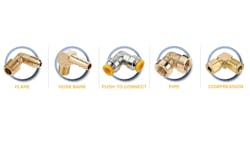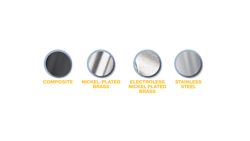Selecting the Perfect Push-to-Connect Fitting: 7 Key Factors
When it comes to choosing a fitting, ease of installation is a key factor to consider. Especially at a time when many seasoned technicians are retiring and being replaced by younger, less experienced workers, manufacturers are seeking connection solutions that don’t require as much experience and ones that will reduce installation labor time on the job. That's largely why push-to-connect fittings (also referred to as quick disconnects, quick couplings, push-to-connect/push-on/push-fit, plug-in fittings, quick manifolds, and quick-release couplings) have become popular over the past 20+ years.
Some experts in the industry estimate the labor reduction to be as high as 90% when using push-to-connect fittings because no tools are required. Fast, easy assembly additionally translates into lower total cost.
However, not all push-to-connect fittings are the same, and it's important to choose the right one to ensure optimal performance and avoid premature failures.
Understanding the STAMPED Criteria for Choosing the Right Fitting
Choosing the right fitting comes down to what's known as the STAMP(ED) method of selection. For years, the acronym most associated with fitting selection was known as STAMP. The "ED" was added in recent years and includes "E", which refers to ends (thread type), and "D", which stands for delivery (an especially important consideration now that inventories are leaner).
The core part of the acronym stands for Size, Temperature, Application, Material/Media, and Pressure. STAMPED is an industry-wide practice used by engineers and operators as a guide when replacing or determining specs for new hydraulic or pneumatic hoses and fittings. Following the STAMPED guidelines will help ensure you install the best push-to-connect fitting for your application.
Size Considerations for Push-to-Connect Fittings
When calculating size, consider the inside diameter (ID) and outside diameter (OD) of the fitting.
The ID must be able to keep pressure loss to a minimum and maintain adequate flow while avoiding damage to the system as a result of heat generation or excessive turbulence. The ID, along with the flow rate and design of the fitting, will determine the fluid velocity through the fitting. If the fitting is too small, you may experience a reduced flow rate and loss of pressure, as well as additional noise and increased temperatures. If the flow and pressure remain restricted for too long, the system could sustain damage.
Temperature Considerations for Push-to-Connect Fittings
When evaluating temperature, there are two different variables: The temperature of the material conveyed and environmental temperature.
It's important to choose a fitting that's appropriate for the temperatures to not cause damage. Fittings will have a longer service life if they're not continually used at working pressures or temperatures beyond manufacturer specifications.
Temperature can have a significant impact on the overall working pressure because maximum working pressures will decrease as temperatures increase. When choosing a specific fitting, keep in mind that push-to-connect fittings are often rated for average, minimum, and maximum operating temperatures.
Application Considerations for Push-to-Connect Fittings
In this case, application refers to all those conditions in which the push-to-connect fitting will be used, including environment and type of industry, equipment type, cycle life, indoor vs. outdoor use, maintenance requirements, and the potential for exceeding the maximum pressure ratings. Consideration should be given to anything that could compromise the service life of the fitting, whether it's aggressive chemicals, abrasion or vibration, or even extreme temperature.
Material/Media Considerations for Push-to-Connect Fittings
Typical media include fluids, inert gas, chemicals, and compressed air which are commonly used in pneumatic and hydraulic processes. Special attention should be paid to applications that use media that are toxic or caustic to ensure that all of the materials used on the chosen push-to-connect fitting (whether metal, rubber, plastic, composite, nickel-plated brass, electroless-nickel plated brass, or stainless steel) are compatible and able to stand up to the aggressiveness of the media regardless of prolonged contact or contact under extreme pressures and/or temperatures.
Pressure Considerations for Push-to-Connect Fittings
The pressure rating for the push-to-connect fitting should be equal to or greater than the system pressure. Pressure spikes, even those that occur for short intervals, can shorten the life of the fitting if they extend beyond the maximum working pressure of the fitting. Remember, too, that temperatures inside and outside the system can affect the pressures within the systems and should be taken into consideration when evaluating the ability of the chosen fitting to withstand pressures during normal operating conditions, as well as pressure spikes.
Ends Considerations for Push-to-Connect Fittings
When considering the various ends (thread types) of a fitting, think about the coupling design, style, type, and any relevant safety features. Remember that the ends on either side of the fitting are not always the same. For example, on one side there may be a compression end and the other side may have a bar. Other common thread types include hose barb, gladhand, hose clamp, and jubilee clip, among others. The pressures and volume flow demand of the system will dictate the best thread types and connection methods.
Since the area where the hose and fitting meet is often the weakest point and most vulnerable to failure and leaks, choosing the right end is especially important. Some professionals recommend the addition of a safety locking mechanism to help strengthen the integrity of the connection.
Delivery Considerations for Push-to-Connect Fittings
The delivery phase includes multiple steps, including testing, packaging, and delivery. Various industry standards and relevant certifications often dictate how this phase should be addressed.
Improvements in Push-to-Connect Offerings
It was Parker that first developed and patented the original push-to-connect technology more than 30 years ago. At that time, most push-to-connect fittings were made from thermoplastics. Since then there have been a number of improvements made to push-to-connect fittings for them to adapt to greater demands. For example, grab rings enhance tube retention and there are newer versions that have higher tube tension and higher hold strength. Some of these newer designs are even faster and easier to install than the original push-to-connect styles.
With the addition of advanced materials, such as nylon, and value-added engineering, there are also lighter-weight push-to-connect fittings available. In addition to the obvious labor savings, these newer designs provide a number of environmental benefits.
As a result of stricter regulations and certification requirements in recent years, there's an increased focus on flame retardance. This has opened the door to the use of glass-filled nylon which is known for providing greater flame resistance. Companies like Parker have also developed options to handle higher pressures. Today, Parker offers the highest pressure rating—up to 290 psi for compressed air and up to 435 psi with stainless tubing.
Alternatives to Push-to-Connect Technologies
Despite the proven advantages of push-to-connect fittings, there are still some in the industry who continue to prefer the use of old-school compression fittings due to the perception that they're more durable. Considering that even Class A trucks use push-to-connect fittings, there should be no concerns about reliability.
There are, however, a few applications for which push-to-connect fittings are not recommended. For example, the Department of Transportation (DOT) insists that air brake fittings for vehicles must be copper-based. In addition, push-to-connect fittings should not be used in conjunction with propane, gas, or other highly explosive media. Yet another vulnerability of push-to-connect fittings is tuber tension which will cause fitting failures at higher pressures because the tubing can pull out and get soft at higher temperatures and pressures.
Conclusion
Today there are more low-pressure connection options than ever before. Although the STAMPED evaluation method helps direct specifiers in the right direction, it's often still not ideal to have to make a final selection on your own. That's why it's important to choose a supply partner with deep experience in both hydraulic and pneumatic systems to provide the necessary technical expertise to help guide you through the STAMPED process and assure a push-to-connect option is best for your application. Ideally, your chosen partner will also have a broad portfolio of connection products so you don't have to settle for a second-best solution simply because the right option was not in inventory.
About the Author

Michael Nick
Product Sales Manager, Parker Hannifin
Michael Nick is a product sales manager for Parker Hannifin.


